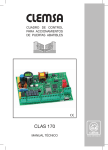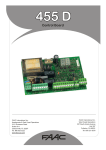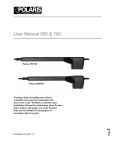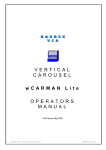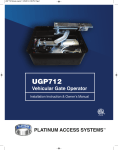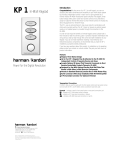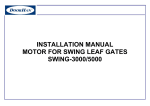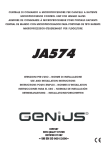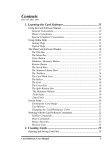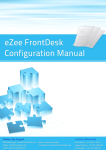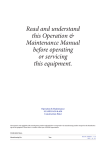Download installation manual faac 412
Transcript
The 412 Operator and 450 MPS Control Panel: Installation Manual Contents Important Safety Information........................................................................ 2 Technical Data .............................................................................................. 4 The 412 Compact Operator.................................................................... 4 The Control Panel .................................................................................. 4 Unpacking the Operator ................................................................................ 5 The 412 Compact Operator........................................................................... 6 General Characteristics .......................................................................... 6 Operating Logic ..................................................................................... 6 Manual Release Mechanism ........................................................... 6 General Operating Logic ................................................................ 7 Logical Operating Modes ............................................................... 7 Installation Instructions............................................................................... 10 Prepare the Gate................................................................................... 10 Install the Operator .............................................................................. 10 Establish the Orientation of the Operator and the Gate Leaf ........ 10 Attach the Rear Mounting Bracket .............................................. 10 Attach the Operator to the Rear Mounting Bracket ...................... 12 Attach the Operator to the Front Mounting Bracket ..................... 12 Attach the Front Mounting Bracket to the Gate Leaf ................... 12 Attach the Operator Cover............................................................ 13 Install the 450 MPS Control Panel...................................................... 14 Connect the Main Power Supply .................................................. 14 Connect One Activating Device ................................................... 15 Connect the Operator(s) to the Control Panel.............................. 15 Check the Motor’s Direction of Rotation .................................... 17 Connect Other Devices ................................................................. 17 Set Operating Controls......................................................................... 20 Set DIP Switches .......................................................................... 20 Adjust the Potentiometers ............................................................. 20 Maintenance ................................................................................................ 21 The 412 Operator ................................................................................. 21 The Control Panel ................................................................................ 21 Troubleshooting .......................................................................................... 22 FAAC International, Inc. 303 Lexington Avenue Cheyenne, WY 82007 Important Safety Information Both the installer and the owner and/or operator of this system need to read and understand this installation manual and the safety instructions supplied with other components of the gate system. This information should be retained by the owner and/or operator of the gate. Gate Design 1. A gate is a potential traffic hazard, so it is important that you locate the gate far enough away from the road to eliminate the potential of traffic getting backed up. This distance is affected by the size of the gate, how often it is used, and how fast the gate operates. WARNING! To reduce the risk of injury or death 2. The operator you choose to install on your gate must be designed for the type and size of your gate and for the frequency with which you use the operator. 3. Your gate must be properly installed and must work freely in both directions before the automatic operator is installed. 4. An automatic operator should be installed on the inside of the property/fence line. Do not install the operator on the public side of the property/fence line. 5. Pedestrians should not use a vehicular gate system. Prevent such inappropriate use by installing separate gates for pedestrians. 6. Exposed, reachable pinch points on a gate are potentially hazardous and must be eliminated or guarded. 7. Outward swinging gates with automatic operators should not open into a public area. 8. The operating controls for an automatic gate must be secured to prevent the unauthorized use of those controls. 9. The controls for an automatic gate should be located far enough from the gate so that a user cannot accidentally touch the gate when operating the controls. 1. READ AND FOLLOW ALL INSTRUCTIONS. 2. Never let children operate or play with gate controls. Keep the remote control away from children. 3. Always keep people and objects away from the gate. NO ONE SHOULD CROSS THE PATH OF THE MOVING GATE. 4. 5. 6. 7. Test the gate operator monthly. The gate MUST reverse on contact with a rigid object or stop when an object activates the non-contact sensors. After adjusting the force or the limit of travel, retest the gate operator. Failure to adjust and retest the gate operator properly can increase the risk of injury or death. Use the emergency release only when the gate is not moving. KEEP GATES PROPERLY MAINTAINED. Read the owner’s manual. Have a qualified service person make repairs to gate hardware. 10. An automatic gate operator should not be installed on a gate if people can reach or extend their arms or legs through the gate. Such gates should be guarded or screened to prevent such access. The entrance is for vehicles only. Pedestrians must use separate entrance. Installation 1. If you have any question about the safety of the gate operating system, do not install this operator. Consult the operator manufacturer. 8. SAVE THESE INSTRUCTIONS. There are three kinds of safety issues involved with an automatic gate operator: issues arising from the design of the gate, from the installation of the gate and the operator, and from the use of the gate operator. The following information is designed to help you be sure your gate and its operator are well-designed, installed correctly, and used safely. 2 2. The condition of the gate structure itself directly affects the reliability and safety of the gate operator. 3. Only qualified personnel should install this equipment. Failure to meet this requirement could cause severe injury and/or death, for which the manufacturer cannot be held responsible. 4. 5. 6. 7. The installer must provide a main power switch that meets all applicable safety regulations. 1. Use this equipment only in the capacity for which it was designed. Any use other than that stated should be considered improper and therefore dangerous. 2. When using any electrical equipment, observe some fundamental rules: Clearly indicate on the gate with a minimum of 2 warning signs (visible from either side of the gate) that indicate the following: • Do not touch the equipment with damp or humid hands or feet. • Do not install or operate the equipment with bare feet. • Do not allow small children or incapable persons to use the equipment. • The gate is automatic and could move at any time, posing a serious risk of entrapment. • Children should not be allowed to operate the gate or play in the gate area. 3. • The gate should be operated only when it is visible to the operator and the when the area is free of people and obstructions. If a gate system component malfunctions, turn off the main power before making any attempt to repair it. 4. Do not attempt to impede the movement of the gate. You may injure yourself as a result. 5. This equipment may reach high temperatures during operation; therefore, use caution when touching the external housing of the operator. 6. Learn to use the manual release mechanism according to the procedures found in this installation manual. 7. Before carrying out any cleaning or maintenance operations, disconnect the equipment from the electrical supply. 8. To guarantee the efficiency of this equipment, the manufacturer recommends that qualified personnel periodically check and maintain the equipment. It is extremely unsafe to compensate for a damaged gate by overtightening a clutch or increasing hydraulic pressure. Devices such as reversing edges and photocells must be installed to provide better protection for personal property and pedestrians. Install reversing devices that are appropriate to the gate design and gate application. 8. Before applying electrical power, be sure that the voltage requirements of the equipment correspond to your supply voltage. Refer to the label on your operator system. Use U.L. Class and FAAC Operator Model Duty Cycle Typical Use Class I: Residential Vehicular Gate Operator 402 750 Limited duty 422 760 412 • • Home use Small apartment building, for example, up to 4 units in a building, with limited public access Class II: Commercial/General Access Vehicular Gate Operator 400 640 Continuous duty • Apartment buildings 620 • Very public access Class III: Industrial/Limited Access Vehicular Gate Operator 400 640 Continuous duty • 620 Class IV: Restricted Access Vehicular Gate Operator 620 640 Continuous duty • 3 No public access Prison rated security Technical Data The 412 Compact Operator Parameter 1 Voltage required , VAC Measure 230, +6 or −10%, 50−60 Hz 115, +6 or -10%, 50−60 Hz Duty type Residential duty Maximum duty cycle 2 18 cycles/hr 30 cycles/hr Maximum leaf length, ft (m) 14 (4.3)g Maximum leaf swing, deg 3 Thrust and traction , ft-lb (Nm) 110 0−294 (0−400) 0−235 (0−320) Stroke, in. (cm) 4 Rod speed , in./sec (cm/sec) 11 3/8 (29) 3/4 (1.9) 5/8 (1.6) Thermal cut out, deg F (deg C) 284 (140) 39 5/16 × 3 3/4 × 7 9/16 Operator dimensions, l × w × h, in. (cm) (99.8 × 9.5 × 19.2) Operator weight, lb (kg) Current draw, A Maximum amperage draw for accessories, mA 14.3 (6.5) 5 2 300 360 1 Your standard 220 VAC power supply meets the specification for 230 VAC, +6 or −10% 2 While the 412 Operator is capable of 18 or 30 cycles/hr, as a residential-duty operator it is not designed for such continuous, sustained operation. 3 Additional torque may be available for heavier gate leaves if you change capacitors. Call our Technical Department. Note that any change in the capacitors may affect duty cycle. 4 The 90-deg opening time for a gate with the 412 Operator is a maximum of about 46 sec. Note that both the mounting dimensions and the torque adjustment help to determine the precise opening speed. • • • • • The Control Panel The 450 MPS control panel is installed with the 412 Compact Operator. Both the control panel and the operator must use the same power supply voltage. Power source: Use the power source that matches both the operator and the control panel. To determine the voltage requirement of your operator, look at the label on the operator. To determine the voltage requirement of your 450 MPS control panel, refer to the label on the transformer of the control panel. Note that your standard 220 VAC power source meets the specification for 230 VAC (+6 or −10%, 50−60 Hz). The control panel allows you to set these parameters: • • The pause time The torque The operating logic for your gate system The reversing stroke function of the operator The behavior of triggered reversing devices Operating logics available: A, S, E, EP, B, and C. The closing leaf delay for a two leaf gate system (note the opening leaf delay is fixed at 2.5 sec) The opening/closing time 4 Unpacking the Operator When you receive your 412 Compact Operator, complete the following steps. 2 1 Inspect the shipping box for physical damage such as a torn carton. Then inspect the operator after you remove it from the box. Notify the carrier immediately if you note any damage because the carrier must witness the damage before you can file a claim. 1 As you unpack the box, insure that all the parts listed below are included (also see Figure 1). Your kit (a pair of operators) has these parts: 1 2 Control panel box with control panel installed inside (only 1 per kit). Inside the enclosure is a package of 4 screws to hold the lid on the enclosure and 4 plugs for the surface mounting knockout holes. 412 Operator units. One is marked SX and one is marked DX. Be sure to install each on the proper gate leaf (see Figure 2). Protective covers for the worm screw housing of the operator Package of mounting hardware: 2 Rear mounting brackets 2 Rear mounting plates that attach to the gate post (or column) 2 Front mounting brackets that attach the operators to the gate leaves Parts package: 2 Capacitors 2 End caps 2 Plastic inserts for the protective cover 2 Manual Release keys 2 Plugs for covering the Manual Release keyhole 6 Snap rings 4 Screws for attaching the cover to the operator 2 Long pins for rear mounting (each requires 1 snap ring) 2 Short pins for front mounting (each requires 2 snap rings) Front bracket Worm screw Cover Rear bracket Power cable Motor Cable cover Figure 1. Parts of the 412 Compact Operator (SX model is shown) Figure 2. Mount the proper model (SX or DX) on the gate leaf whether the gate swings inward or outward. 5 The 412 Compact Operator mechanism and a torque adjustment mechanism that precisely controls the force transmitted to the gate leaf through the 412 Operator. General Characteristics The FAAC 412 Compact Operator is an automatic gate operator for a swinging gate leaf. The 412 Compact Operator is useful in apartment and other residential applications and can accommodate a gate leaf up to 14 ft (4.3 m) long. The Manual Release mechanism is a key-operated device that disengages (or engages) the worm screw drive of the 412 Operator. When the drive is disengaged, you can open and close the gate leaf by hand. Such manual operation of the gate is necessary during installation and useful during power failures. The self-contained 412 Compact Operator consists of an electric motor that drives a worm screw housed in an aluminum casing. The torque of the 412 Operator is controlled by a potentiometer located on the 450 MPS control panel. FAAC recommends that the gate leaf stop if it encounters a force of more than about 33 lb (15 kg). The locking the 412 Operator provides in the fully opened and fully closed positions is a service device rather than a security device. Additional, external locks are recommended under the following conditions: • • • • • Reversing devices (such as inductive loops and photocells) should be installed to provide non-contact reversing operation. Yours is a solid-faced gate. The length of the gate leaf is 6 ft (2 m) or longer. The installation requires tight security. The site is subject to vandalism. The site is subject to strong or very gusty wind. Operating Logic The 412 Operator provides a Manual Release mechanism for manually operating the gate. Manual operation of the gate requires using a special key. The 450 MPS Control Panel provides logical operating modes set on the control panel. For gates with two leaves, two operators are installed. Each of them is designed for either the right or left gate leaf: If the hinge is on the left as you face the gate on the side where the operator will be installed, you want a left or SX version; if the hinge is on the right when you face the gate on the side where the operator will be installed, you want a right or DX version. A kit has one right and one left version. Manual Release Mechanism The Manual Release mechanism is a built-in release device of the 412 Operator (see Figure 3). To access the keyhole, remove the plug on the top of the motor housing. Then insert the key and turn it a half turn in the direction of the gate’s closing to disengage the operator’s motorized operation. You can now move the gate leaf by hand to open or close the gate. Operating the gate leaf by hand is necessary during installation and is useful during power failures. In two-operator gate installations, both operators are wired to one control panel. In such gate installations, one leaf can be wired and programmed to close slightly later than the other leaf to accommodate overlapping gate designs. The 450 MPS electronic control panel is a microprocessor-based controller that accepts a wide range of product accessories and reversing devices, thus allowing for flexible gate system design. The control panel sets the closing leaf delay, the opening/closing time, the pause time, the torque, the operating logic of the gate system, the function of the reversing stroke (required for some electric locks), and the behavior of triggered reversing devices during the closing phase. 1. Remove the plug on the top of the motor housing 2. Insert the Manual Release key and turn it in the closing For its protection, the single-phase, bidirectional motor shuts off automatically if its operating temperature reaches 284 deg F (140 deg C). Also for the protection and proper operation of the 412 Operator, each gate leaf on which it is installed must have a fixed positive stop in both the opened and closed positions. Figure 3. Use the Manual Release key to disengage the 412 Operator from its motor so that you can move the gate leaf by hand in the opening or closing direction Built-in security and anti-crushing measures of the 412 Operator include a key-operated Manual Release 6 • You re-engage the motor of the operator by turning the key one full turn in the direction of the gate’s opening. Remove the key and replace the plug. General Operating Logic Given the electromechanical nature of the 412 Operator, the behavior of the operator when it encounters an obstacle is always the same no matter which logical mode of operation has been set on the control panel. • • If an obstruction interrupts the gate’s opening, the gate stops its movement (depending on the weight of the obstruction) though the motor continues to run its entire cycle. Sending a signal after the interruption in opening causes the gate to close. • WARNING! The pressure the gate leaf applies to an obstruction is determined by the torque adjustment setting. It is the installer's responsibility to make sure the torque is correctly set. • If an obstacle interrupts the gate’s closing, the gate stops its movement, though the motor continues to run its entire cycle. Sending another signal causes the gate to reopen. • WARNING! Any triggered reversing or stopping device prevents an activating command from being recognized. You cannot activate the gate to open or close until the reversing or stopping device has been cleared. A (automatic): The gate opens on command and automatically closes after a pause phase. A second command on opening is ignored; a second command during the pause phase causes the gate to close immediately; a second command during closing reopens the gate. S (security): The automatic mode is like A logic except that a second command during opening immediately closes both gate leaves. E (semi-automatic): This mode requires a command to open and a command to close. A second command during opening or closing causes the gate leaves to stop all motion. A third command then closes the gate. EP (semi-automatic, step by step): This mode requires a command to open and a command to close. A second command during opening or closing causes the gate leaves to stop all motion. A third command then reverses the previous motion of the gate leaves. B (manned, pulsed): This mode is designed for guard station use and requires a threebutton switch (pulsed) to open, close, and stop the gate barrier. C (manned and constant): This mode is designed for guard station use and requires at least a two-button switch (constant pressure required on each button) to open, close, and stop the gate barrier (no pressure on a button stops the gate). WARNING! FAAC strongly recommends that you install a non-contact reversing device for all gate systems. Logical Operating Modes Note: Reversing devices are either opening reversing devices or closing reversing devices, depending on where the device is connected on the terminal strip. FAAC strongly recommends the use of reversing devices no matter which logic you choose for your gate operation. WARNING! Any triggered reversing or stopping device prevents an activating command from being recognized. You cannot activate the gate to open or close until the reversing or stopping device has been cleared. Refer to the operating logic tables on the next two pages for more detail. The logics available on the 450 MPS control panel are briefly described below. You can find a complete description of each logic in the tables on the following pages. 7 A (Automatic) Logic Gate Status Open A Open B Closed Opens both leaves and closes them after pause time No effect Opening No effect Opens single leaf connected to Motor 1 and closes it after pause time No effect Opened Closes both leaves immediately Closes leaf immediately Closing Opens both leaves immediately Closes the leaves Opens leaf immediately Closes the leaf Stopped Stop Opening Reversing Device(s) No effect Closing Reversing Device(s) No effect Off No effect On Stops Stops; gate closes when reversing device no longer triggered No effect On Stops No effect No effect (opening is inhibited) No effect Gate remains open until reversing devices no longer triggered Depends on DIP switch 4 No effect (opening is inhibited) Stops Warning Light Flashes On S (Security) Logic Gate Status Open A Open B Closed Opens both leaves and closes them after pause time No effect Opening Closes both leaves immediately Opens single leaf connected to Motor 1 and closes it after pause time Closes the leaf immediately Opened Closes both leaves immediately Closes leaf immediately Closing Opens both leaves immediately Closes the leaves Opens leaf immediately Closes the leaf Stopped Stop Opening Reversing Device(s) No effect Closing Reversing Device(s) No effect Off No effect On Stops Stops; gate closes when reversing device no longer triggered No effect On Stops No effect No effect (opening is inhibited) No effect Gate remains open until reversing devices no longer triggered Depends on DIP switch 4 No effect (opening is inhibited) Stops Warning Light Flashes On B (Manned, Pulsed) Logic Gate Status Closed Opening Opened Closing Stopped Open A Opens 1 or both leaves No effect No effect No effect Opens 1 or both leaves Open B Stop No effect No effect Opening Reversing Device(s) No effect No effect Closes 1 or both leaves No effect Closes 1 or both leaves Stops No effect No effect No effect Stops No effect On On Stops No effect Stops No effect No effect No effect Flashes On 8 Closing Reversing Device(s) No effect Off Warning Light E (Semi-automatic) Logic Gate Status Open A Open B Stop Closed Opens both leaves No effect Opening Stops Opens single leaf connected to Motor 1 Stops Opened Closes both leaves immediately Closes leaf immediately Stops Closings Stops Stops Stops Stopped Closes the leaves Closes the leaf No effect (opening is inhibited) Stops Opening Reversing Device(s) No effect Closing Reversing Device(s) No effect Off Stops; gate closes when reversing device no longer triggered No effect No effect On No effect (opening is inhibited) Depends on DIP switch 4 No effect (opening is inhibited) On No effect (opening is inhibited) No effect Warning Light Flashes On EP (Semi-automatic, Step by Step) Logic Gate Status Open A Open B Stop Closed Opens both leaves Opening Stops Opens single leaf connected to Motor 1 Stops No effect (opening is inhibited) Stops Opened Closes both leaves immediately Closes leaf immediately Stops Closing Stops Stops Stops Stopped Gate leaves reverse direction Gate leaf reverses direction No effect (opening is inhibited) Opening Reversing Device(s) No effect (opening is inhibited) Stops; gate closes when reversing device no longer triggered No effect No effect (opening is inhibited) No effect (opening is inhibited) Closing Reversing Device(s) No effect (opening is inhibited) No effect No effect (opening is inhibited) Depends on DIP switch 4 No effect (opening is inhibited) Warning Light Off On On Flashes On C (Manned and Constant) Logic Gate Status Closed Opening Opened Closing Stopped Open A Opens 1 or both leaves No effect No effect No effect Opens 1 or both leaves Open B Stop No effect No effect Opening Reversing Device(s) No effect No effect Closes 1 or both leaves No effect Closes 1 or both leaves Stops No effect No effect No effect Stops No effect On On Stops No effect Stops No effect No effect No effect Flashes On 9 Closing Reversing Device(s) No effect Off Warning Light Installation Instructions Installing the 412 Operator involves preparing the gate, installing the operator(s), installing the control panel, setting the torque adjustments on the control panel, and setting other operational controls. Follow the instructions below to install your operator whether in an inward or outward swinging configuration. Note: The following installation instructions assume you are fully capable of installing an electromechanical operator on a gate. This manual does not instruct you in designing a gate, installing a gate (whether on masonry, wood, or metal posts), or basic electrical wiring. The installation tasks discussed in this manual are tasks peculiar to the 412 Operator. Prepare the Gate Before you install the 412 Operator, you need to prepare the gate itself for the operator. Be sure to do the following three things: 1. Make sure that the gate structure is solidly built. Add reinforcing crosspieces if necessary to the gate leaves. 2. Make sure that the gate moves smoothly on its hinges without excessive friction by swinging it opened and closed by hand. If necessary, lubricate all the gate's moving parts. 3. Provide limit stops for the gate leaves in the fully opened and fully closed positions (see Figure 4). Install the Operator Installing the operator consists of the following steps: • Establishing the orientation of each gate leaf and its operator. • Attaching the rear mounting bracket • Attaching the operator to the rear mounting bracket • Attaching the front mounting bracket to the operator • Attaching the front mounting bracket to the gate leaf • Attaching the operator’s protective cover • Installing the 450 MPS control panel • Adjusting the torque for the operator • Setting the operating controls Establish the Orientation of the Operator and the Gate Leaf Before you begin mounting brackets or attaching parts, you first need to establish the proper orientation of each operator in relation to its gate leaf. Figure 2 (page 4) shows a biparting gate from the side where the operators are mounted. The operator attached to the hinge on the left of the gate must be an SX model. If the hinge is on the right side, the DX model must be installed. Installing the operator on the wrong side makes it impossible to install the cover of the operator. Once you have prepared the gate, you are ready to proceed with the installation of the operator. Attach the Rear Mounting Bracket Limit stop Inward swinging gate: You need to determine whether to attach the rear mounting bracket directly to the post (or wall) or to notch the post and install a recessed liner. Large pillars require a recessed liner to house the rear mounting bracket and part of the operator so that the pillar will not interfere with the swing of the gate when it is fully opened. Closed gate Opened gate Limit stop Figure 4. Provide positive limit stops for the gate leaf 10 To determine whether you need a recessed liner, measure the distances B and D (shown in Fig. 5) on your gate. If your measure of B or D is greater than the dimensions shown for your operator in Figure 5, notch the post and construct a recessed liner for the post B Axis of rotation for gate leaf Gate post (or column) Center of gate leaf A E D C F a Mounting Dimensions 90-deg Swing 110-deg Swing A 5 3/4 in. (14.5 cm) 4 7/8 in. (12.5 cm) B 5 3/4 in. (14.5 cm) 4 7/8 in. (12.5 cm) WARNING! A and B should differ by no more than 1/2 in. Larger differences may dangerously alter the speed of operation. C D 4 in. (10 cm) 3 1/8 in. (8 cm) E 3 1/8 in. (8 cm) 3 1/8 in. (8 cm) F a b 35 1/8 in. (89.2 cm) Absolute minimum of 1 3/4 in. (4.5 cm) Gate speed increases as the dimensions A and B decrease. The torque adjustment may also affect the gate speed. The sum of A and B must equal a minimum of 3 5/8 in. (9 cm). Figure 5. Important mounting dimensions for inward-swinging 412 operators, top view 11 13/16 in. (30 cm) mounting bracket (see Figure 6). The recessed liner should be constructed of 3/16 or 1/4 in. steel with a minimum interior height of 11 13/16 in. (30 cm) so as to allow you to meet the required dimensions shown in Figure 5. Make sure the recessed liner is securely embedded in the post (or wall). 4 in. (10 cm) There are two parts to the rear mounting bracket. The horizontal bracket attaches to the operator, and the slotted vertical plate attaches to the gate post (see Figure 8). Weld the two parts together and bolt the assembly to the gate post of column. Note, though, that use of the vertical rear mounting plate is optional. 5 29/32 in. (15 cm) Once you have positioned the rear mounting bracket, attach the bracket to the post (or wall or recessed liner), making sure the dimensions on your gate system match those shown in Figure 5. Figure 6. The required dimensions of the recessed liner when notching the gate post 11 top of the motor assembly, and turn the key a half turn in the direction of the gate’s closing. Outward swinging gate: If you are installing the 412 Operator to swing the gate outward, construct a steel elbow of sufficient size to attach to the gate pillar and rear mounting bracket (see Figure 7 for elbow dimensions). You should be able to lengthen or shorten the cylinder covering the operator’s worm screw by pulling or pushing the cylinder. Lengthen or shorten the operator to the required distance for your gate installation: Attach the Operator to the Rear Mounting Bracket Inward swinging: Lengthen the worm screw completely and push the cylinder in one inch. Attach the operator to the rear mounting bracket with the long pin and one snap ring on the bottom (see Figure 8). Outward swinging: Shorten the worm screw completely and then pull the cylinder out one inch. Attach the Operator to the Front Mounting Bracket Attach the operator to the front mounting bracket with the short pin and one snap ring on the bottom and one snap ring on the top (see Figure 9). With the gate in the fully closed position, temporarily clamp the front mounting bracket (previously attached to the operator) to the gate leaf and insure that the cylinder of the worm screw is level. Attach the Front Mounting Bracket to the Gate Leaf Move the gate leaf by hand to the fully opened position against the gate stop and insure that the cylinder is level. Disengage the operator’s worm screw drive from its motor with the Manual Release. Insert the key in the Gate post (or column) Axis of rotation for gate leaf Centerline of gate leaf E D A F C Steel elbow B a Mounting Dimensions A B 90-deg Swing 110-deg Swing 5 3/4 in. (14.5 cm) 4 7/8 in. (12.5 cm) 5 3/4 in. (14.5 cm) 4 7/8 in. (12.5 cm) WARNING! A and B should differ by no more than 1/2 in. Larger differences may dangerously alter the speed of operation. C D a b 24 1/4 in. (62 cm) 4 in. (10 cm) 3 1/8 in. (8 cm) E Absolute minimum of 3 1/8 in. (8 cm) F Absolute minimum of 1 3/4 in. (4.5 cm) Gate speed increases as the dimensions A and B decrease. The torque adjustment may also affect the gate speed. The sum of A and B must equal a minimum of 3 5/8 in. (9 cm). Figure 7. Important mounting dimensions for outward-swinging 412 operators, top view 12 Next, you must determine that the worm screw has not reached the full extent of its travel. Remove the operator from the front mounting bracket and push or pull the cylinder in the direction of it opening direction of travel: dimensions are incorrect (see Figure 5 or 7, whichever applies to your installation). Reattach the rear mounting bracket as necessary. Once the front mounting bracket is welded in place, you can reattach the operator to the bracket. Inward swinging: You should be able to push the cylinder in about an inch. Attach the Operator Cover Outward swinging: You should be able to pull the cylinder out about an inch. Once the operator is attached to the gate leaf, you next prepare the cover for installation. If the worm screw was not at the full extent of its travel when attached to front mounting bracket, then with the operator detached from the front mounting bracket, permanently attach (weld) the front mounting bracket to the gate leaf (see Figure 10). Caution: If you did not correctly establish the orientation of the gate leaf and properly install the DX model on the right side and SX on the left side, you will be unable to install the cover on either operator. If the worm screw was at the full extent of its travel, try moving the front mounting bracket toward the hinge and retesting. If again the front mounting fully extends the worm screw, then the rear mounting Position the mounting insert inside the aluminum cover and then slide the aluminum cover into position. Secure the cover and insert with the short screws provided (see Figure 11). 4 3/8 in. (11 cm) 2 3/4 in. (7 cm) Figure 10. Weld the front mounting bracket into position after insuring the operator is level in the fully closed and fully opened positions Figure 8. Attach the operator to the rear mounting bracket (an SX version is shown) The plastic cover insert has a slot that must align with the slot in the cover End cap for cover Minimum of 3 1/8 in. (8 cm) from the back of the vertical mounting plate to the center of the front mounting hole on the operator Figure 11. Attach the cover with two screws (SX model shown) Figure 9. Secure the operator to the front mounting bracket with the short pin and 2 snap rings 13 Connect the Main Power Supply Install the 450 MPS Control Panel WARNING! Turn the main power off before you make any electrical connections or set any switches inside the control panel box. Locate the control panel in the most convenient position possible, considering the movement of the gate. For example, a good position for the control panel box is on the inner face of the post or pillar. Figure 12 shows the typical layout for a two-leaf gate with two 412 Operators. Wire the main power supply to control panel terminals in block J1 (see Figures 13 and 14). The installer is responsible for insuring that a separate, grounded circuit protected by a circuit breaker is between the control panel and the main power supply. All wiring should conform to applicable electrical codes, and all wiring and fittings should be weatherproof and/or suitable for burial. Installing the control panel consists of the following general steps: • Connecting the main power to the control panel • Connecting an activating device • Connecting the operator(s) to the control panel • Checking the motor’s direction of rotation WARNING! The voltage of the main power must match the required voltage of the 412 Operator and the 450 MPS control panel. • Connecting other devices (activating and reversing) to the control panel The installer is responsible for grounding the operator systems, for providing the main power breaker switch, and for making sure that the entire gate system meets all applicable electrical codes. Connect the ground to the grounding terminal in block J1 and connect the power wires to the terminals labeled N (neutral) and L (phase). Caution: The operators are grounded only by the grounded circuit the installer provides. C B A D B Locate switches at least 10 ft from the gate A Gate Elements Wire Gauges for Given Voltage 1 412 Operators: Note: Each requires a junction box A 2 × 18 AWG for accessories 2 Photocells B 4 × 14 AWG for the operators 3 450 MPS control panel and enclosure C 5 × 18 AWG for the activating devices 4 Operation switch (2 or 3 button) D 4 × 14 AWG up to 410 ft for the main power 5 Radio receiver 6 Warning light Figure 12. The layout of a sample gate system 14 1 J1 terminal block for main power supply 8 Leaf delay potentiometer 2 J2 terminal block for connecting the operator(s) 9 DIP switch assembly 3 J3 terminal block for low-voltage accessories Fuses 220 VAC 115 VAC 4 J4 quick connector port 10 F1, Main power 5A 10 A 5 Pressure adjustment potentiometer 11 F2, Accessories 800 mA 800 mA 6 Pause time potentiometer 12 F3, Electric lock 1.6 A 1.6 A 7 Potentiometer for adjusting open/close time 13 F4, Microprocessor Figure 13. The 450 MPS control panel 250 mA 250 mA You use this activating device in the rest of the installation process. You can connect additional activating devices later. Connect One Activating Device WARNING! Turn the main power off before you make any electrical connections or set any switches inside the control panel enclosure. Connect the Operator(s) to the Control Panel For the purposes of installation you need to connect at least one normally open (N.O.) activating device for your operator(s). • • WARNING! Turn the main power off before you make any electrical connections or set any switches inside the control panel box. If you have a two-leaf gate design, connect the activating device to terminals 18 and 19. Using a Junction Box Connecting your operator(s) to the control panel may require the use of one or more junction boxes. Whether you need 0, 1, or 2 U.L. Listed junction boxes depends on your gate design (refer to Figure 15 below). If you have a one-leaf gate design, connect the activating device to terminals 16 and 17. 15 1 2 3 4 5 6 7 8 9 10 11 12 13 14 15 16 17 18 19 20 21 22 23 24 25 Figure 14. The terminal strip wiring of the 450 MPS (b) (a) To the U. L. Listed gate operator U.L. Listed Control Panel Enclosure 450 MPS Control Panel Junction box U.L.Listed cord grip High-voltage terminal strip Legend Red Black J1 J3 J2 White 1 Yellow/ Green 2 Lamp 3 4 5 6 7 8 OP COM CL CL COM OP Motor 1 Motor 2 Ground To the U.L. Listed control panel Conduit to U.L. Listed control panel enclosure according to N.E.C. Op. 1 Op. 2 Cord grip or conduit from U.L. Listed gate operator(s) (see text) Figure 15. Wiring detail (a) inside the junction box and (b) from the junction box or operator to the high-voltage terminal strip on the 450 MPS control panel 16 If any operator is more than 2 ft away from the U.L. Listed control panel enclosure, the connection must be made inside a junction box. Use a U. L. Listed cord grip where the operator cord enters the junction box; use conduit between the junction box and the enclosure. Disengage the operator(s) with the Manual Release key, and open the gate by hand about halfway. Connecting the Operator(s) Turn on the main power and send an activating signal to the operator. The gate leaf (or leaves) should open. If a gate leaf closes, then you need to turn off the main power and reverse the connection of the brown and black (or red and black) wires on terminal block J2 for the operator controlling that leaf. Then you need to recheck the rotation direction again. Next, engage the operator(s) with the Manual Release key so that you can check the rotation of the motor(s). Caution: Do not use the terminal connections for Motor 2 (terminal 6, 7, and 8) if yours is a one-leaf gate design. Note: If you have a one-leaf gate design, the operator must be connected to Motor 1 (terminals 3, 4, and 5). If your gate system has two operators, be sure the motor of each rotates in the correct direction. If your gate system has one operator, connect the capacitor and the brown and black (or red and black) wires from your operator to the terminals 3 and 5 in block J2 for Motor 1. Connect the blue (or white) wire from the operator to terminal 4 for Motor 1. After having completed your test of the motor’s direction of rotation, replace any test circuits you installed (between terminals 11 and 13, between 13 and 21, and between 14 and 15) with the proper reversing and stop devices. The instructions for installing such accessories follow. Note: If you want to delay the closing of one gate leaf in a two-leaf gate design, be sure to connect its operator to Motor 1 (terminals 3, 4, and 5). Connect Other Devices WARNING! Turn the main power off before you make any electrical connections or set any switches inside the control panel box. If your gate system has two operators, connect the second operator to terminals 6, 7, and 8 in block J2 for Motor 2. Connect the capacitor and the brown and black (or red and black) wires to terminals 6 and 8, and connect the blue (or white) wire from the operator to terminal 7 for Motor 2. Now you can connect additional reversing and activating devices to the control panel. Refer to Figure 13 for the general control panel layout, and refer to Figure 14 for the layout of the terminal strip. Check the Motor’s Direction of Rotation Note: The 450 MPS control panel allows a maximum accessory load of 500 mA. After you have connected the main power supply, one activating device, and the operator(s) to the control panel, you need to check the direction of rotation for each operator motor in your gate design. Power Supply for Accessories: You can access a 30 VDC output for supplying power to accessories that require DC voltage through terminals 9 and 10 (located above the label 30 Vcc) on terminal block J3. In most cases, this source can be used to power 24 VDC accessories. To check a motor’s direction of rotation, you must have three closed circuits on terminal block J3. Install one circuit between terminals 11 and 13, another circuit between 13 and 21, and another circuit (or stop device) between terminal 14 and 15. Reversing Devices: Reversing devices include photocells, inductive loops, and so forth. All of the reversing devices should have contacts of the normally closed (N.C.) type. Where you connect a device depends on whether you want the device to operate during opening or during closing. You cannot check the motor’s direction of rotation without these circuits (jumpers) or the accessories. When properly prepared for testing, the LEDs DL2 and DL3 should be illuminated. WARNING! Running the operator—even for testing purposes—without a connected reversing device is potentially dangerous. Do not place yourself within the path of the moving gate during your test. Note: A reversing device is required for a U.L. recognized installation. Caution: Failure of a reversing device that operates during opening causes a gate to lock 17 in the closed position and requires the use of the Manual Release key. In addition, terminal block J3 requires a fail-safe connection for the photocells. Connect the photocells to terminals 20 and 21 in the FSWTX grouping. To wire photocells, refer to Figure 14 (see FSWOP for opening photocells, and FSWCL for closing photocells—the photocells must be wired as shown). See Figure 16 for the wiring of inductive loops. In either case, if you have multiple devices, wire them in series. Activating Devices and Radio Receiver: The activating devices and radio receiver for your gate must have normally open (N.O.) contacts. If you have only one gate leaf, connect such devices to terminals 16 and 17. If your gate has two leaves, connect the devices to terminals 18 and 19. FAAC International, Inc., strongly recommends you install reversing devices. If you choose not to install such devices, then you must install the necessary circuit(s) for the control panel to work. Figure 17 shows how to connect a three-wire receiver, and Figure 18 shows how to connect a four-wire receiver. If you do not install a closing reversing device, install a circuit between 13 and 21 on terminal block J3. LOCK 1 2 3 4 5 6 7 8 9 10 11 12 13 14 15 16 17 18 19 20 21 22 23 24 25 Free Exit/Safety Loop Detector 3 2 1 NO NC NO COM A: 1 = COM 2 = NC 3 = NO B: 4 = COM 5 = NO 6 = RESET 7=+ 8=9 & 10 = LOOP NC • If you do not install an opening reversing device, install a circuit between 11 and 21 on terminal block J3. COM • In addition, terminal block J3 requires a fail-safe connection for the transmitter of the photocells. Connect the transmitter to terminals 20 and 21 in the FSWTX grouping. Figure 16. Wiring diagram showing loop detector 18 White wire leads 9 10 + — 30 Vcc 11 12 13 14 15 16 17 18 19 20 21 OP — CL FSW NC — STOP B A — — 22 23 Stop Button: The stop button you install must have normally closed (N.C.) contacts. Multiple stop buttons must be wired in series. Connect your stop device between terminals 14 and 15. 24 25 + — + — FSWTX W.LIGHT LOCK Note: If you choose not to install a stop button, you must install a circuit between these terminals for the control panel to work. COM NO 24 VDC The LED Indicators: The five light-emitting diodes (LEDs) on the control panel can be used to check for the proper functioning of the devices you attach to the control panel. The LED lights are on whenever the contacts are closed across each of the respective terminals. 3-Wire Receiver Figure 17. Connect a three-wire receiver 9 10 + — 30 Vcc 11 12 13 14 15 16 17 18 19 20 21 OP — CL FSW NC — STOP B A — NC — 22 23 24 25 + — + — FSWTX W.LIGHT NO COM DL1 and DL2 should illuminate only when an activating signal is sent for 2 and 1 gate leaves, respectively. DL3 should be illuminated except when the stop button is pressed. DL4 and DL5 should be illuminated except when the reversing devices, for opening and closing, respectively, are triggered. Use the LEDs and the table below to determine if the accessory devices you have installed are operating properly. LOCK + – 4 Wire Receiver LED DL1, Open 2 leaves DL2, Open 1 leaf DL3, Stop Figure 18. Connect a four-wire receiver Decoder Card: If you are installing the Digicard magnetic card reader, or the Digikey keyboard, use the quick-fit connector J4 for the DS (formerly the MD01) decoder card (see Figure 13). Open/Hold Open Device: To open and hold open the gate, an Open/Hold Open device must make a set of contacts across terminals 18 and 19 (or 16 and 17) and must break a set of contacts between terminals 13 and 21 (see Figure 19). DL4, FTSW Open DL5, FTSW Close WARNING! Any triggered reversing or stopping device prevents an activating command from being recognized. You cannot activate the gate to open or close until the reversing or stopping device has been cleared. 9 10 + — 30 Vcc 11 12 13 14 15 16 17 18 19 20 21 OP — CL FSW NC — STOP B A COM NO — — 22 23 Off Command inactive Command inactive Command active Opening reversing device triggered Closing reversing device triggered Electric Lock: An electric lock can make use of the reversing stroke function controlled by DIP switch 5. A reversing stroke is a short closing phase that allows the electric lock time to disengage itself before the operator starts its opening. Use DIP switch 5 if necessary for your lock to function correctly. Connect your lock to terminals 24 and 25. The terminals provide 12 VAC pulsed power. 24 25 + — + — FSWTX W.LIGHT On Command active Command active Command not active Opening reversing devices not triggered Closing reversing devices not triggered LOCK Relay 24 VDC SPDT Magnetic Lock: Figure 20 shows how to connect a mag lock to the 450 MPS control panel. Switch NC Figure 19. Connect an Open/Hold Open device to the 450 MPS control panel 19 9 10 + — 30 Vcc 11 12 13 14 15 16 17 18 19 20 21 OP — CL FSW NC — STOP B A – — Mag Lock — + 22 23 24 25 + — + — FSWTX W.LIGHT COM Relay NC 24 VDC SPDT LOCK Figure 20. Connect a mag lock to the 450 MPS with an external relay Warning Light: Connect a warning light to terminals 22 and 23 in the group labeled W.LIGHT in terminal block J3. The terminals provide an output voltage of 30 VDC, maximum power 3 Watts. This output voltage will power most 24 VDC warning lights. Note: The behavior of the warning light varies according to the logic you have set. Logics A, S, E, EP, and B: The warning light is on steadily during opening and the pause phase. During closing, the light flashes. Logic C: The warning light is on steadily during opening and flashes during closing. according to the following scheme: Logic 1 Switch 2 3 A S E EP B C off on off on on off off off on on on off off off off off on on Switch 4 (Reversing Device Behavior on Closing) Refer to the operating logic tables earlier in this manual and to the chart below for how to set DIP switch 4. Gate Behavior During Closing Gate immediately reverses its direction when a reversing device is triggered Gate stops and reverse its direction when reversing device is no longer triggered Switch 4 off on Switch 5 (Reversing Stroke) Set Operating Controls Some electric locks require a reversing stroke to disengage the lock. If your lock requires this reversing stroke, set DIP switch 5 according to the following chart. WARNING! Turn off the main power before you make any electrical connections or set any switches inside the control panel box. Note: Some DIP switch assemblies are labeled differently depending on their date of manufacture. OPEN indicates off and ON indicates on. Reversing Stroke Not activated Activated You need to set DIP switches and adjust some potentiometers on the control panel for your gate's operation. The 450 MPS Control Panel has 5 DIP switches and 4 potentiometers that control a wide range of functions. Set DIP Switches Switches 1, 2, and 3 (Operating Logic) The 450 MPS Control Panel offers six operating modes: A, S, E, EP, B, and C. B and C logic are appropriate for guard station applications of the 412 Operator. Refer to the operating logic tables earlier in these instructions for more detail. Switches 1, 2, and 3 control the operating logic 20 Switch 5 off on Adjust the Potentiometers The four potentiometers control the torque, the pause time between opening and closing, the opening/closing time of operation, and the leaf delay on closing. Leaf Delay You may choose to delay one leaf on closing for overlapping gate leaves. Be sure the operator on the leaf for delayed closing is connected to Motor 1. On opening, the leaf connected to Motor 2 is delayed 2.5 sec. Pause Time The pause time between opening and closing can be adjusted from 5 to 240 seconds. Turn the potentiometer clockwise to increase the pause time and counterclockwise to decrease the pause time. Note: You cannot adjust this opening delay of the operator connected to Motor 2. However, you can avoid the opening delay—and closing delay—by connecting both operators (and their capacitors) to Motor 1. Opening/Closing Time The opening/closing time is adjustable from 10 to 62 seconds. The approximate opening/closing time for a 90-degree opening is 18 seconds. Turn the potentiometer clockwise to increase the time and counterclockwise to decrease the time. The closing leaf delay time is adjustable from 0 to 28 seconds. Turn the potentiometer clockwise to increase the time and counterclockwise to decrease the time. Note: If one-leaf gate designs, be sure to set the potentiometer for leaf delay to its minimum (0 seconds). For optimal operation, set the time so that the motor remains active for a few seconds after the leaf has reached its limit stop for opening and for closing. Note: If the opening/closing time is set at less than the leaf delay time, the delayed leaf closes at the end of the closing time. Maintenance The 412 Operator The Control Panel The FAAC 412 Operator requires no maintenance. Periodically inspect the operator, however, to confirm the suitability of the hardware. The control panel requires no maintenance, but every six months you should verify that the torque adjustment setting is appropriate. FAAC recommends that the torque be set so that the gate leaf stops if it encounters a force of more than about 33 lb (15 kg). 21 Troubleshooting WARNING! Turn the main power off before you make any electrical connections or set any switches or potentiometers inside the control panel box. Problem: The gate does not respond to an activating signal. Solutions: Verify that you have correctly wired the operator to the control panel. Determine if the fault is in the receiver by temporarily connecting a push button device across the activating terminals. If such a push button device opens the gate, repair or replace the receiver. Verify that you have correctly wired the activating device to the control panel. Where you connect activating devices depends on whether you have a oneleaf gate or a two-leaf gate. Refer to Figure 14. Problem: The gate doesn't open (or close) though the motors are running. Solutions: Make sure that the motor is running in the right direction, and make sure the Manual Release mechanism has fully engaged the worm screw drive. Check the LED DL3. The LED should be illuminated. If it is not, then the stop device is preventing your gate from opening or closing. Increase the torque in small 1/4 turn increments to see if the system needs more torque. Check fuses F1 (for the motor[s] of the operator[s]) and F2 (for accessories such as activating devices). If necessary, replace a worn out fuse. Problem: The gate opens but does not close. Solutions: Make sure you have selected the desired operating mode. Verify that your activating device works properly. Either the LED DL1 (for a two-leaf gate) or DL2 (for a one-leaf gate) should turn on when you signal the gate to open or to close. Verify that the reversing devices are working properly. The LEDs DL4 and DL5 should be illuminated. If they both are not illuminated, then one of your reversing devices is preventing the gate from responding to your signal. Check the devices. • • If neither LED turns on when you signal the gate, then the problem may be in your activating device. Short across the relevant terminals for your gate design. If the short causes the gate to close (or open), then the problem is in the activating device. Repair or replace the device. If the wrong LED turns on, then you need to rewire the activating device to match the number of gate leaves you have. Problem: The radio controlled opener does not open the gate. Solutions: Check the light on the front of the remote transmitter. It should illuminate when you signal the gate. If it does not illuminate and if the batteries are okay, repair or replace the transmitter. Verify that the wiring for the radio controlled device is correct. The device should be wired to the proper terminals, B and – or A and – in block J3. Check the LED DL1 (for a two-leaf gate) or DL2 (for a one-leaf gate). One of them should turn on when you signal the gate to open or to close. If neither one illuminates, then check the wiring for the antenna and correct it if necessary. 22 If the motor is running, insure that the torque adjustment is correctly set. Increase the torque in small 1/4 turn increments to see if the system needs more torque. Problem: The gate does not fully open (or close). Solutions: Check the operator's opening/closing time selection. You should set the potentiometer so that the motor runs long enough for the gate to open or close. Check to see that there are no obstructions in the path of the gate or that the hinges are not binding. Increase the torque to see if the system needs more torque. Problem: The operator doesn't work smoothly and the gate jerks as it opens and closes. Solutions: Make sure the Manual Release mechanism has fully engaged the worm screw operation of the operator. Make sure that a flexible gate leaf is not the problem. If the gate leaf flexes, then stiffen the gate or use a slower operator. Limited Warranty To the original purchaser only: FAAC International, Inc., warrants, for twelve (12) months from the date of invoice, the gate operator systems and other related systems and equipment manufactured by FAAC S.p.A. and distributed by FAAC International, Inc., to be free from defects in material and workmanship under normal use and service for which it was intended provided it has been properly installed and operated. FAAC International, Inc.'s obligations under this warranty shall be limited to the repair or exchange of any part of parts manufactured by FAAC S.p.A. and distributed by FAAC International, Inc. Defective products must be returned to FAAC International, Inc., freight prepaid by purchaser, within the warranty period. Items returned will be repaired or replaced, at FAAC International, Inc.'s option, upon an examination of the product by FAAC International, Inc., which discloses, to the satisfaction of FAAC International, Inc., that the item is defective. FAAC International, Inc. will return the warranted item freight prepaid. The products manufactured by FAAC S.p.A. and distributed by FAAC International, Inc., are not warranted to meet the specific requirements, if any, of safety codes of any particular state, municipality, or other jurisdiction, and neither FAAC S.p.A. or FAAC International, Inc., assume any risk or liability whatsoever resulting from the use thereof, whether used singly or in combination with other machines or apparatus. Any products and parts not manufactured by FAAC S.p.A. and distributed by FAAC International, Inc., will carry only the warranty, if any, of the manufacturer. This warranty shall not apply to any products or parts thereof which have been repaired or altered, without FAAC International, Inc.'s written consent, outside of FAAC International, Inc.'s workshop, or altered in any way so as, in the judgment of FAAC International, Inc., to affect adversely the stability or reliability of the product(s) or has been subject to misuse, negligence, or accident, or has not been operated in accordance with FAAC International, Inc.'s or FAAC S.p.A.'s instructions or has been operated under conditions more severe than, or otherwise exceeding, those set forth in the specifications for such product(s). Neither FAAC S.p.A. or FAAC International, Inc., shall be liable for any loss or damage whatsoever resulting, directly or indirectly, from the use or loss of use of the product(s). Without limiting the foregoing, this exclusion from liability embraces a purchaser's expenses for downtime or for making up downtime, damages for which the purchaser may be liable to other persons, damages to property, and injury to or death of any persons. Neither FAAC S.p.A. or FAAC International, Inc., assumes nor authorizes any person to assume for them any other liability in connection with the sale or use of the products of FAAC S.p.A. or FAAC International, Inc. The warranty hereinabove set forth shall not be deemed to cover maintenance parts, including, but not limited to, hydraulic oil, filters, or the like. No agreement to replace or repair shall constitute an admission by FAAC S.p.A. or FAAC International, Inc., of any legal responsibility to effect such replacement, to make such repair, or otherwise. This limited warranty extends only to wholesale customers who buy directly through FAAC International, Inc.'s normal distribution channels. FAAC International, Inc., does not warrant its products to end consumers. Consumers must inquire from their selling dealer as to the nature and extent of that dealer's warranty, if any. This warranty is expressly in lieu of all other warranties expressed or implied including the warranties of merchantability and fitness for use. This warranty shall not apply to products or any part thereof which have been subject to accident, negligence, alteration, abuse, or misuse or if damage was due to improper installation or use of improper power source, or if damage was caused by fire, flood, lightning, electrical power surge, explosion, wind storm, hail, aircraft or vehicles, vandalism, riot or civil commotion, or acts of God. FAAC International, Inc. 303 Lexington Avenue Cheyenne, WY 82007 412 IM, 9/98
























